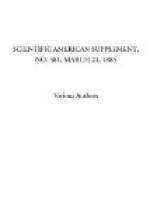As to the drum, the same might be constructed as follows, viz.: First solder the partitions into the cylinder, making them slanting or having the direction of chords of a circle (see Fig. 2). The end disks should be dish shaped, as shown. Place them on a level surface, apply heat, and melt some mastic or good sealing wax in the same. Then adjust the cylinder part, with its partitions, allowing it to sink into the slight depth of molten matter. In this way, or perhaps by employing a solution of rubber instead of the sealing wax, the chambers will be well isolated and not liable to leak. The water is then introduced through the center openings of the disks before hermetically sealing the drum to its axis.
[Illustration: Fig. 3.]
The revolving parts of the clock being nicely balanced, a pretty accurate timepiece, I should think, would be the result. It is needless to mention that the “winding” is effected by slipping the weight to its highest point.
Of course I am far from considering the above an “instrument of precision,” but would rather look upon it in the light of a contrivance, interesting, perhaps, especially to amateur mechanics, as not presenting any particular difficulties of construction.
Ed. C. Magnus.
Crefeld, January 5, 1885.
* * * * *
NEW TORPEDO.
We illustrate a new form of self-propelling and steering torpedo, designed and patented by Mr. Richard Paulson, of Boon Hills, Langwith, Notts. That torpedoes will play an important part in the next naval war is evident from the fact that great activity is being displayed by the various governments of the world in the construction of this weapon. Our own Government also has latterly paid great attention to this subject.
The methods hitherto proposed for propelling torpedoes have been by means of carbonic acid or other compressed gas carried by the torpedoes, and by means of electricity conveyed by a conductor leading from a controlling station to electrical apparatus carried by the torpedo. The first method has, to a considerable extent, failed on account of the inefficient way in which the compressed gas was employed to propel the torpedo. The second is open to the objection that by means of telephones placed in the water or by other signaling apparatus the torpedo can be heard approaching while yet at a considerable distance, and that a quick speeded dredger, kept ready for the purpose when any attack is expected, can be run between the torpedo and the controlling station and the conductor cut and the torpedo captured. The arrangements for steering by means of an electrical conductor from a controlling station are also open to the latter objection. The torpedo we now illustrate, in elevation in Fig. 1, and in plan in Fig. 2, is designed to obviate these objections, and possesses in addition other advantages which will be enumerated in the following description.




